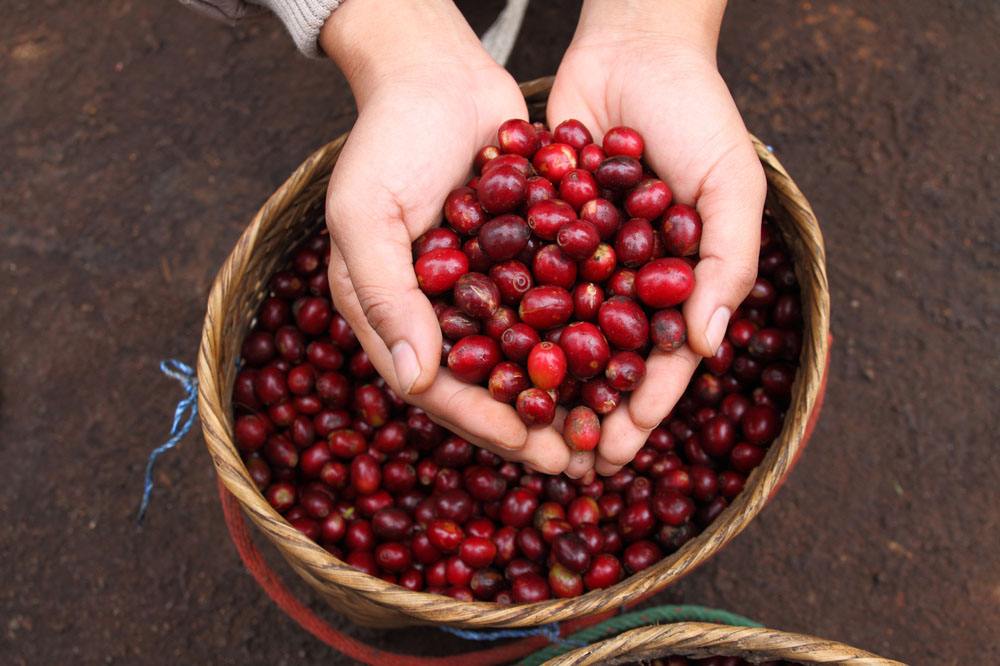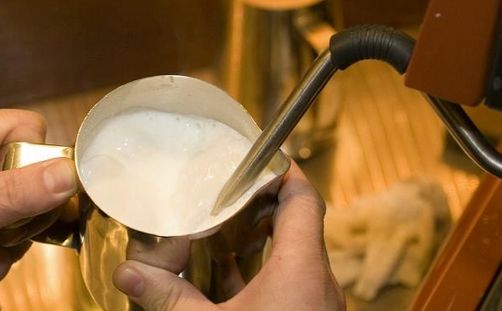Coffee theory: what is decaf?
Follow the caf é (Wechat official account vdailycom) and found that Beautiful Cafe opened a small shop of its own.
Decaf coffee, as its name implies, is coffee with only a small amount of caffeine. Coffee contains many ingredients and substances, among which caffeine has an obvious effect on the human body. For many people who are addicted to coffee but whose physical condition does not allow caffeine, decaf is the best choice.
In general, Arabica coffee beans contain 1.1%-1.7% caffeine, while robusta beans contain 2%-4.5% d caffeine. Decaf coffee is required to contain no more than 0.3% caffeine in brewed coffee. That means no more than 5 milligrams of caffeine in a cup of decaf.

The step of low-cause treatment can only be carried out in the state of sub-coffee and raw beans. Today, there are three main types of treatments to remove caffeine: traditional / European treatment (European Process), Swiss water treatment (SWP,Swiss Water Process), and CO supercritical Process (CO2 supercritical treatment). All three methods are very effective in removing most caffeine, leaving only 20.3% of the total amount of original caffeine in coffee beans.
European / solvent treatment (The European or Solvent Process): there are two variations in solvent treatment. The first is direct solvent treatment. First, the stomata of raw coffee beans are opened with steam, and the solvent is directly added to the coffee beans. After the solvent is fused with caffeine, it is brought out by steam. The other is indirect solvent treatment, in which all the flavors of raw coffee beans are dissolved in hot water (this is a hypothetical state, not all compound beans are really dissolved out), and after a period of time, raw coffee beans are separated from hot water with "all" flavors (including caffeine), and then a solvent that attracts caffeine is added to the hot water. At this point, caffeine binds to the solvent and rises to the surface, which can be easily removed, and then the decaffeinated hot water is recombined with raw coffee beans, which absorb the remaining flavor factors.
Swiss Water treatment method (The Swiss Water-Only Process): using this commercially developed and efficient treatment method, there are two major steps. The first step is to pour the raw coffee beans into hot water, which will remove almost all the flavor factors in the raw coffee beans, including caffeine, and discard the original batch of raw coffee beans. After that, the hot water loaded with all flavor factors is filtered out by activated carbon filter, and the rest is hot water full of pure flavor factors, which is called "flavor full water" (Flavor-charged Water) in Swiss water treatment. This kind of water contains all the flavor factors that should be found in raw coffee beans, except for caffeine, which is a special water. Is the most important medium in the next decaffeinated process.
A new batch of raw coffee beans soaked in water full of flavor factors and non-caffeine will release caffeine in raw coffee beans, but will not release flavor factors. In this way, the original flavor of raw coffee beans will not be impaired too much. Obviously, the flavor factor in the flavor-loaded water is already close to saturation, so it can no longer dissolve more flavor factors, but there is still a lot of room to dissolve caffeine.
After this process of removing caffeine and retaining flavor factors, raw coffee beans are dried and sold directly, while the flavor that absorbs caffeine is filled with water, which can be removed by activated carbon filter over and over again.
Carbon dioxide supercritical Process (CO supercritical carbon dioxide): carbon dioxide supercritical treatment is to soak raw coffee beans in liquid carbon dioxide. Under high pressure, carbon dioxide presents a semi-gaseous and semi-liquid state. In this state, carbon dioxide can be actively combined with caffeine, and caffeine is finally removed by exhaust activated carbon filter.
Either way, the extracted caffeine is resold to cola or pharmaceutical companies for reuse, and caffeine is not wasted at all. As for the flavor of decaf coffee, Viagra can only be said to be unflattering here. You can't have both fish and bear's paw. Since you need decaf coffee more, you can only give up the flavor.
Treatment method
At present, there are three ways to remove caffeine from coffee beans:
1. Water treatment can remove 9496% of the caffeine.
2, chemical extraction method, early use chloroform (Chloroform), benzene (Benzene) as the solvent to extract caffeine, later understand that these chemicals cause cancer, and gradually be replaced by other low-hazard chemicals, but after all, the chemical substances are not natural enough, this method can extract 96% of caffeine.
3. The third method is supercritical carbon dioxide treatment, and its extraction rate can reach 960.98%. The most efficient of the three ways to remove caffeine.
Carbon dioxide (CO2) treatment:
Two natural elements, pure water and carbon dioxide (a mixture of the two we often call soda) are used to extract caffeine from raw coffee beans. The founder of this method is Kurt Zosel.
In chemistry, we also call it supercritical CO2 extraction technology. The density of supercritical carbon dioxide (hereinafter referred to as SC-CO2) is hundreds of times that of gas and close to that of liquid, but its viscosity is similar to that of gaseous carbon dioxide. Its diffusion coefficient is about 1% of that of a gas and hundreds of times larger than that of a liquid. Therefore, the movement (Mass transfer) or distribution of substances is faster than that in liquid solvents.
This method was developed to extract caffeine from coffee beans because of the following characteristics:
1. The critical temperature of carbon dioxide is 31.1 ℃ and the critical pressure is 73 atmospheric pressure (Atm). It is suitable for the extraction of thermally unstable substances because it is close to the critical temperature at room temperature. It has a good effect on the retention of aroma substances in coffee.
two。 Carbon dioxide is an inactive gas, has no flammability and chemical reactivity, has no residue, is harmless to human body, and does not cause environmental pollution.
3. It is easy to obtain high-purity carbon dioxide and cheap.
The method of supercritical CO2 extraction of caffeine is to make coffee beans absorb water and expand to twice as large. Caffeine molecules move in the bean body, add carbon dioxide and give more than 100 atmospheric pressure (Atm) in the water, so that water and carbon dioxide are mixed to create a soda environment. Carbon dioxide attracts caffeine molecules like a magnet, and when caffeine is captured by carbon dioxide, caffeine begins to move. Carbon dioxide is highly selective and it does not capture carbohydrates and proteins in coffee beans because carbohydrates and proteins are the main components of flavor and smell in coffee beans. When it dries naturally after the extraction, caffeinated water can be easily separated from caffeine and used for other commercial purposes.
Advantages of this method:
1. The extraction efficiency of caffeine is very high, and there is no chemical pollution.
two。 It will not have any chemical changes with carbohydrates and proteins in coffee beans.
3. Its by-product (caffeine) is natural and 100% recyclable!
Important Notice :
前街咖啡 FrontStreet Coffee has moved to new addredd:
FrontStreet Coffee Address: 315,Donghua East Road,GuangZhou
Tel:020 38364473
- Prev

Coffee knowledge learning, coffee beans nutrition introduction
Caffeine is the most noticeable of all coffee ingredients. It belongs to a plant xanthine (animal muscle components), the nature and cocoa contains theobromine, green tea contains theophylline the same, after baking the percentage of reduction is very small, caffeine's role is extremely extensive. Caffeine Caffeine is the most noticeable of all coffee ingredients. It's a plant.
- Next

frothing study, making milk as fine and smooth as coffee shop at home
Pay close attention to the coffee comment (Weixin Official Accounts vdailycom ) and find that the beautiful coffee shop opens its own small shop. At present, most household coffee machines on the market come with steam sticks, but due to various reasons such as model and boiler, it is not easy to send milk at home. But we believe that with certain skills and repeated training, everyone can play like a coffee shop at home.
Related
- What is the meaning of lactic acid fermentation with coffee bean treatment?
- How to judge the state of foam by sound?
- How does the latte pull out the unicorn pattern? Come to get for a little trick to improve the flower pull!
- Will flower pulling affect the taste of the latte?
- Do you know the history of coffee?
- The difference between honey treatment and sun washing what is raisin honey treatment?
- What kind of milk can a novice use to make coffee foam to keep the foam longer? The correct method and skills of milking tutorial sharing
- Why do washed coffee beans taste sour? Flavor characteristics of washed Coffee
- Introduction to the skill of how to practice the size and height of water injection around the circle of hand-brewed coffee
- How do beginners practice coffee flower drawing from scratch?

